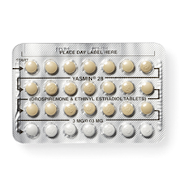How birth control saved my period
I got 99 problems but severe period pain ain’t one.

I was lying on the couch in the middle of summer, wrapped up in a million blankets with a heating pad on my pelvis. Not only did I have a stomachache and heavy bleeding, I was also shivering and feeling extremely nauseous. It wasn’t the first time that a day I was hoping to spend out and about turned into a day of staying in watching movies. My time of the month was here to ruin my plans yet again.
Whenever I mentioned to friends or family how my period interfered with my daily routine—that I had to leave school because the pain was unbearable, that I felt so nauseous I couldn’t get up or eat anything—they all reacted the same way: “It’s normal to cramp,” “The first day of your period is always bad,” “When we were your age we had cramps too.” Even with all of this very, um, supportive feedback, I knew something wasn’t right.
I did what any other young investigator would do and used Google to find out if what I was dealing with was common or if I was in fact an extraterrestrial being. I was relieved to find that many women suffer from severe period pain for various reasons. I narrowed down the causes of my pain to the three most common period-related conditions:
- dysmenorrhea
- endometriosis
- polycystic ovary syndrome (PCOS)
Let’s take a second to get technical…
What is dysmenorrhea?
Dysmenorrhea is when you experience abdominal pain, lower back pain, and cramping while on your period and the symptoms are bad enough to interfere with your daily routine.
What is endometriosis?
Endometriosis is a condition where tissue grows outside of your uterus instead of inside, causing pelvic pain. Because the tissue is growing outside of the uterus, it can’t come out during a period like it would if it were inside. Symptoms include pain in the lower back, abdomen, and pelvis, as well as heavy bleeding, irregular periods, cramping, nausea, and constipation. Endometriosis can lead to infertility if it’s not taken care of. You can technically only be diagnosed with endometriosis through a laparoscopy, a procedure where a mini camera is used to check for tissue or scarring around the outside of the uterus.
What is PCOS?
PCOS is a condition where a hormone imbalance causes cysts to grow on your ovaries. Ovarian cysts can cause pain during sex and heavy, irregular, or painful periods.
A highly recommended solution for all 3 conditions? Hormonal birth control.
As I tried to self-diagnose, I began to panic. What if I have all three conditions? What if birth control doesn’t help? What if I get my period on during graduation or on my wedding day?! I was basically doomed forever.
In the midst of my panic, I scheduled an appointment with my gyno and started asking around about the three conditions in preparation for the visit. One of my friends told me she had experienced similar symptoms and her gyno diagnosed her with PCOS. She revealed that she, “legit used to bleed enough for 6 women and it’s become a lot more controlled with the pill.” This information was encouraging.
The day before my appointment, I texted another close friend of mine who had tweeted about the pill. She said that before the pill, every month when she got her period she would, “have to miss school, feel nauseous, shiver, turn pale, and be miserable for two days.” She had endometriosis. (Pro tip: Search #endowarrior on Twitter for some real talk about dealing with endometriosis.)
I went to the gyno and was prescribed Junel, a generic combined pill. Even though my period didn’t need regularizing, Junel was supposed to help with all the bad and ugly I was experiencing each month: the heavy bleeding, nausea, chills, and other interruptions of my daily life.
My happy ending
The difference was like night and day and happened almost immediately. I felt like a liberated unicorn during my first period on the pill. My flow was light, I wasn’t bleeding nearly as much as before, barely cramping, no nausea, no chills, no difficulty moving and no overbearing, extreme exhaustion. I did experience some nausea during the first month whenever I would drink alcohol close to the time I took the pill (11:00pm) but it was a small price to pay. I was so appreciative of this tiny hormonal pill that I was extremely consistent and diligent with taking it at the same time every day so that I wouldn’t mess up its effectiveness and end up with a shitty period again.
For the past four years that I’ve been on the pill, I haven’t had any problems with my period. Every now and then I might feel some light cramping upon Aunt Flo’s arrival, but it has never been anywhere close to as bad as it was before I started taking the pill.
BTW, the pill isn’t the only method of birth control that can help with painful periods. So if taking a pill every day isn’t your thing—or if you just want to explore all your options—check out other hormonal methods and talk to your health care provider about what could work best for you.
How do you feel about this article?

Heat up your weekends with our best sex tips and so much more.
